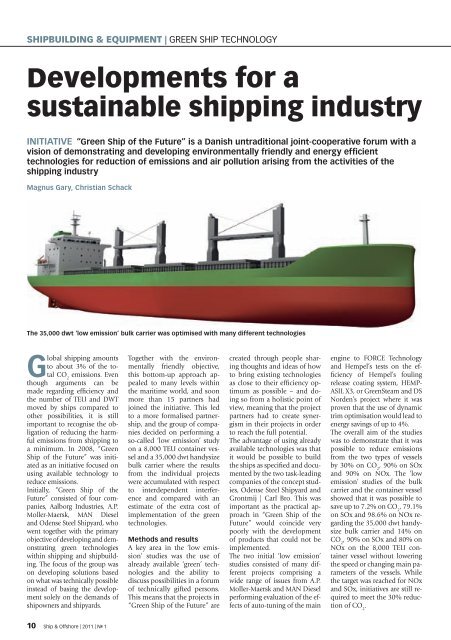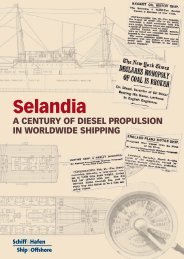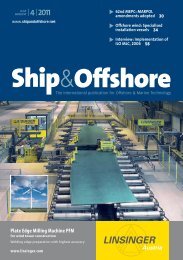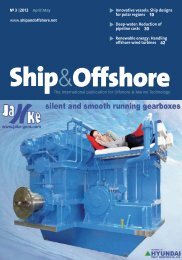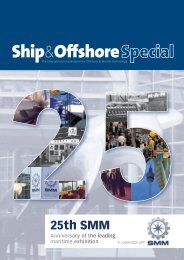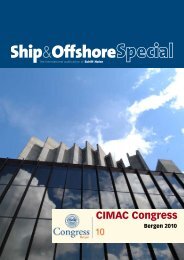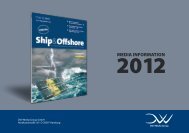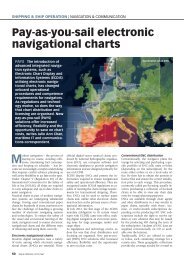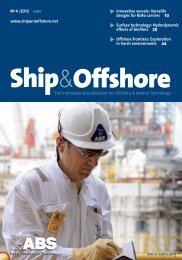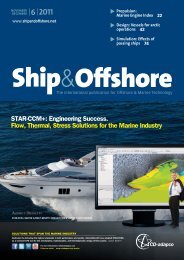Arctic technology: Winterisation of FPSO 38 Cruise ... - Ship & Offshore
Arctic technology: Winterisation of FPSO 38 Cruise ... - Ship & Offshore
Arctic technology: Winterisation of FPSO 38 Cruise ... - Ship & Offshore
Create successful ePaper yourself
Turn your PDF publications into a flip-book with our unique Google optimized e-Paper software.
SHIPBUILDING & EQUIPMENT | GREEN SHIP TECHNOLOGY<br />
Developments for a<br />
sustainable shipping industry<br />
INITIATIVE “Green <strong>Ship</strong> <strong>of</strong> the Future” is a Danish untraditional joint-cooperative forum with a<br />
vision <strong>of</strong> demonstrating and developing environmentally friendly and energy effi cient<br />
technologies for reduction <strong>of</strong> emissions and air pollution arising from the activities <strong>of</strong> the<br />
shipping industry<br />
Magnus Gary, Christian Schack<br />
The 35,000 dwt ‘low emission’ bulk carrier was optimised with many different technologies<br />
Global shipping amounts<br />
to about 3% <strong>of</strong> the total<br />
CO 2 emissions. Even<br />
though arguments can be<br />
made regarding effi ciency and<br />
the number <strong>of</strong> TEU and DWT<br />
moved by ships compared to<br />
other possibilities, it is still<br />
important to recognise the obligation<br />
<strong>of</strong> reducing the harmful<br />
emissions from shipping to<br />
a minimum. In 2008, “Green<br />
<strong>Ship</strong> <strong>of</strong> the Future” was initiated<br />
as an initiative focused on<br />
using available <strong>technology</strong> to<br />
reduce emissions.<br />
Initially, “Green <strong>Ship</strong> <strong>of</strong> the<br />
Future” consisted <strong>of</strong> four companies,<br />
Aalborg Industries, A.P.<br />
Moller-Maersk, MAN Diesel<br />
and Odense Steel <strong>Ship</strong>yard, who<br />
went together with the primary<br />
objective <strong>of</strong> developing and demonstrating<br />
green technologies<br />
within shipping and shipbuilding.<br />
The focus <strong>of</strong> the group was<br />
on developing solutions based<br />
on what was technically possible<br />
instead <strong>of</strong> basing the development<br />
solely on the demands <strong>of</strong><br />
shipowners and shipyards.<br />
10 <strong>Ship</strong> & <strong>Offshore</strong> | 2011 | N o 1<br />
Together with the environmentally<br />
friendly objective,<br />
this bottom-up approach appealed<br />
to many levels within<br />
the maritime world, and soon<br />
more than 15 partners had<br />
joined the initiative. This led<br />
to a more formalised partnership,<br />
and the group <strong>of</strong> companies<br />
decided on performing a<br />
so-called ‘low emission’ study<br />
on a 8,000 TEU container vessel<br />
and a 35,000 dwt handysize<br />
bulk carrier where the results<br />
from the individual projects<br />
were accumulated with respect<br />
to interdependent interference<br />
and compared with an<br />
estimate <strong>of</strong> the extra cost <strong>of</strong><br />
implementation <strong>of</strong> the green<br />
technologies.<br />
Methods and results<br />
A key area in the ‘low emission’<br />
studies was the use <strong>of</strong><br />
already available ‘green’ technologies<br />
and the ability to<br />
discuss possibilities in a forum<br />
<strong>of</strong> technically gifted persons.<br />
This means that the projects in<br />
“Green <strong>Ship</strong> <strong>of</strong> the Future” are<br />
created through people sharing<br />
thoughts and ideas <strong>of</strong> how<br />
to bring existing technologies<br />
as close to their effi ciency optimum<br />
as possible – and doing<br />
so from a holistic point <strong>of</strong><br />
view, meaning that the project<br />
partners had to create synergism<br />
in their projects in order<br />
to reach the full potential.<br />
The advantage <strong>of</strong> using already<br />
available technologies was that<br />
it would be possible to build<br />
the ships as specifi ed and documented<br />
by the two task-leading<br />
companies <strong>of</strong> the concept studies,<br />
Odense Steel <strong>Ship</strong>yard and<br />
Grontmij | Carl Bro. This was<br />
important as the practical approach<br />
in “Green <strong>Ship</strong> <strong>of</strong> the<br />
Future” would coincide very<br />
poorly with the development<br />
<strong>of</strong> products that could not be<br />
implemented.<br />
The two initial ‘low emission’<br />
studies consisted <strong>of</strong> many different<br />
projects comprising a<br />
wide range <strong>of</strong> issues from A.P.<br />
Moller-Maersk and MAN Diesel<br />
performing evaluation <strong>of</strong> the effects<br />
<strong>of</strong> auto-tuning <strong>of</strong> the main<br />
engine to FORCE Technology<br />
and Hempel’s tests on the effi<br />
ciency <strong>of</strong> Hempel’s fouling<br />
release coating system, HEMP-<br />
ASIL X3, or GreenSteam and DS<br />
Norden’s project where it was<br />
proven that the use <strong>of</strong> dynamic<br />
trim optimisation would lead to<br />
energy savings <strong>of</strong> up to 4%.<br />
The overall aim <strong>of</strong> the studies<br />
was to demonstrate that it was<br />
possible to reduce emissions<br />
from the two types <strong>of</strong> vessels<br />
by 30% on CO 2 , 90% on SOx<br />
and 90% on NOx. The ‘low<br />
emission’ studies <strong>of</strong> the bulk<br />
carrier and the container vessel<br />
showed that it was possible to<br />
save up to 7.2% on CO 2 , 79.1%<br />
on SOx and 98.6% on NOx regarding<br />
the 35,000 dwt handysize<br />
bulk carrier and 14% on<br />
CO 2 , 90% on SOx and 80% on<br />
NOx on the 8,000 TEU container<br />
vessel without lowering<br />
the speed or changing main parameters<br />
<strong>of</strong> the vessels. While<br />
the target was reached for NOx<br />
and SOx, initiatives are still required<br />
to meet the 30% reduction<br />
<strong>of</strong> CO 2 .


